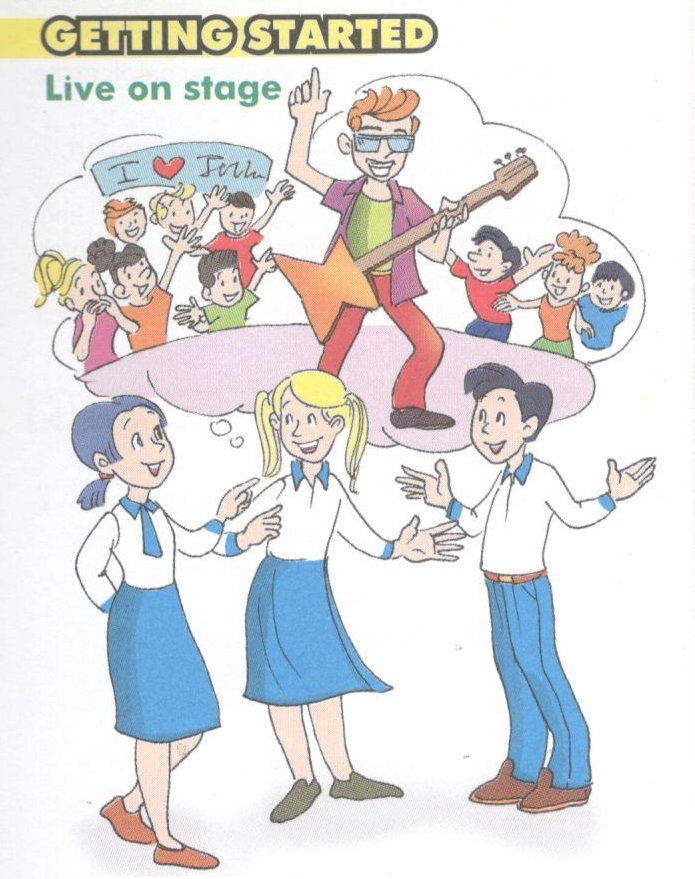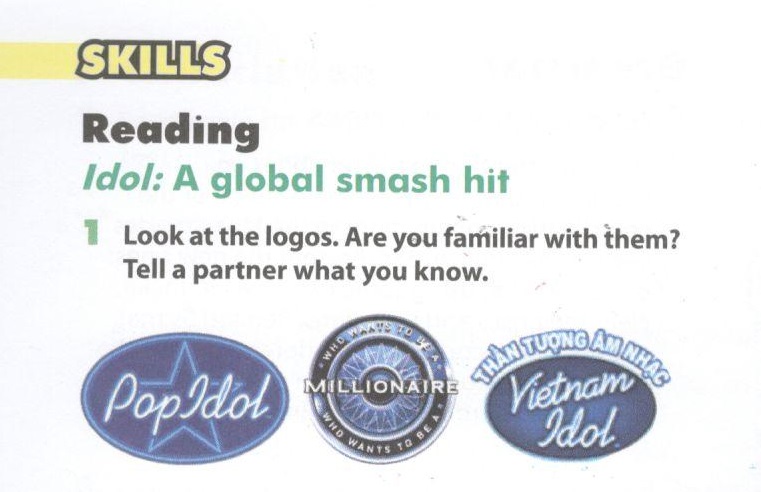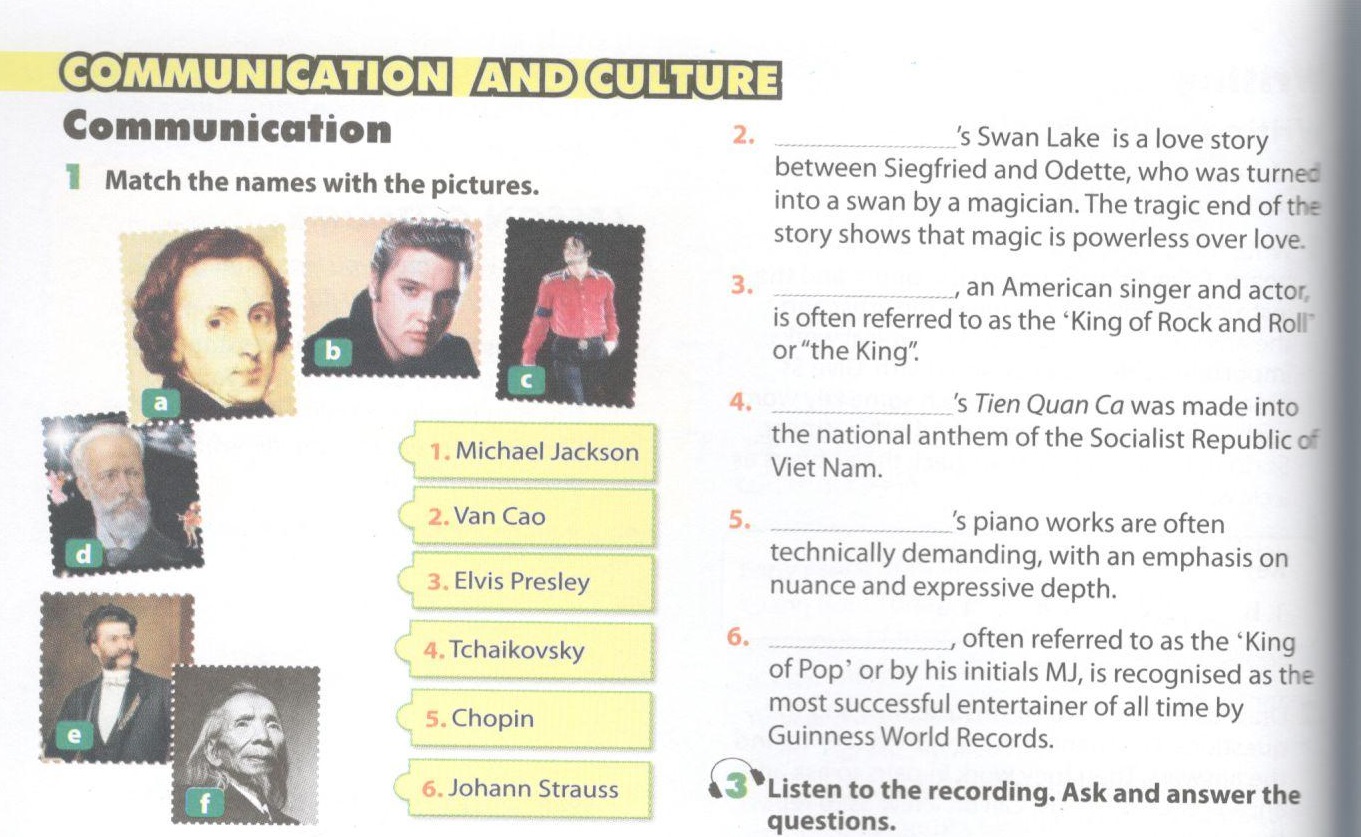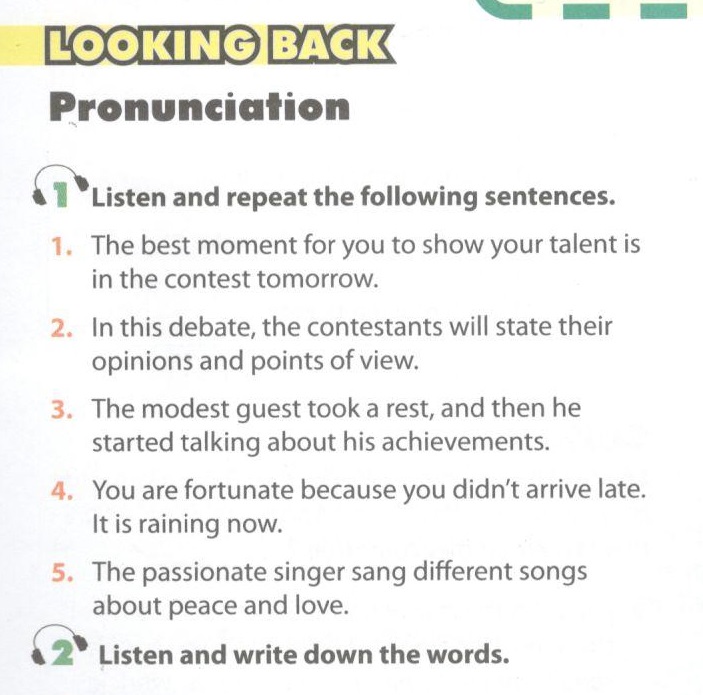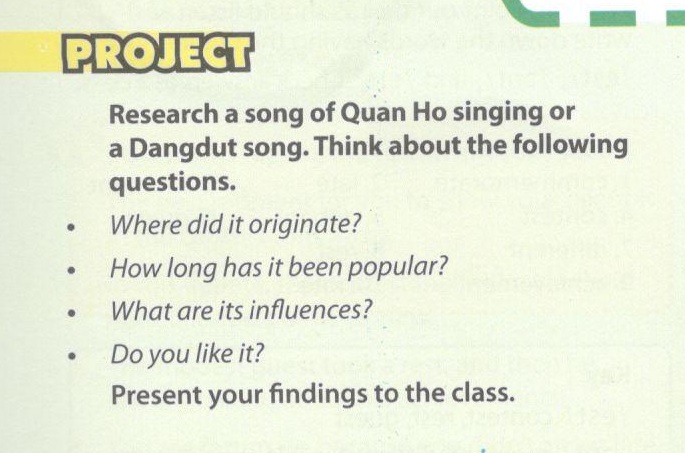
Skills - trang 19 Unit 2 SGK Tiếng Anh 10 mới
Tổng hợp các bài tập phần Skills Unit 2 SGK Tiếng Anh 10 mới.
- Bài học cùng chủ đề:
- Communication and Culture - trang 23 Unit 2 SGK Tiếng Anh 10 mới
- Looking Back - trang 24 Unit 2 SGK Tiếng Anh 10 mới
- Project - trang 25 Unit 2 SGK Tiếng Anh 10 mới
- Ngữ pháp tiếng anh hay nhất
Reading
Acupuncture
1. Look at the picture, do you know anything about acupuncture? (Nhìn vào bức ảnh, bạn có biết gì về châm cứu không?)

2. Read the passage below. In pairs, or groups, choose the three most interesting things you learnt about acupuncture from the passage and report to the class. (Đọc bài văn dưới đây. Làm việc theo cặp hoặc theo nhóm, chọn 3 điều thú vị nhất về châm cứu từ bài viết và trình bày trước cả lớp.)
Acupuncture is one of the oldest medical treatments in the world. It originated in China more than 2,500 years ago. The practice of acupuncture is rooted in the idea of promoting harmony between humans and the world around them and a balance between yin and yang. Although there are unanswered questions, acupuncture appears to work. Scientific studies offer evidence that it can ease pain and treat from simple to complicated ailments.
The technique of acupuncture involves placing hair-thin needles in various pressure points (called acupoints) throughout the body. Stimulating these points is believed to promote the body's natural healing capabilities and enhance its functions. Originally, there were 365 acupoints, but this has increased to more than 2000 nowadays.
Acupuncture is considered to be very safe when enough precautions are taken. The most common side effects with acupuncture are soreness, slight bleeding, or discomfort. Some people may feel tired after a session. Care is also needed so that inner body parts are not touched by the needles.
Despite its general safety, acupuncture isn't for everyone. People who have bleeding problems or are taking blood related medicine should not have the treatment. It's also not recommended for people who have electronic medical devices inside their bodies.
Today, a lot of people use acupuncture as a reliable alternative to modern medicine. According to a U.S. 2002 survey (the most reliable survey to date), an estimated 8.2 million American adults had tried acupuncture. This number has been reported to be increasing steadily.
Dịch bài:
Châm cứu là một trong những thuật trị bệnh cổ xưa nhất trên thế giới. Nó khởi thủy ở Trung Quốc từ hơn 2500 năm trước. Việc thực hiện châm cứu bắt nguồn từ ý tưởng gia tăng sự hài hòa giữa con người và thế giới xung quanh họ và sự cân bằng giữa âm và dương. Mặc dù những thắc mắc chưa được lí giải, châm cứu đã có những hiệu quả nhất định. Khoa học nghiên cứu tìm ra những bằng chứng cho rằng châm cứu có thể giảm đau và và chữa những bệnh từ đơn giản đến phức tạp.
Kỹ thuật châm cứu gồm có việc đặt những mũi kim mỏng như sợi tóc vào những điểm huyệt khác nhau khắp cơ thể. Người ta tin rằng kích thích những điểm này sẽ gia tăng khả năng chữa lành tự nhiên của cơ thể và cải thiện các chức năng của cơ thể. Vốn dĩ, chỉ có khoảng 365 huyệt, nhưng số lượng này đã tăng lên hơn 2000 huyệt hiện nay.
Châm cứu được cho là rất an toàn khi có sự cẩn trọng. Tác dụng phụ thường thấy nhất của châm cứu là cơn đau, chảy máu nhẹ và sự khó chịu. Một vài người có thể cảm thấy mệt mỏi sau khi thực hiện châm cứu. Cần chú trọng để phần nội tạng bên trong cơ thể không bị kim đâm vào.
Mặc dù nhìn chung là an toàn, châm cứu không phải dành cho tất cả mọi người. Những người có vấn đề về việc xuất huyết hoặc đang dùng thuốc có liên quan đến máu không nên chữa trị theo cách châm cứu. Nó cũng không được khuyến khích dùng cho những người sử dụng thiết bị y tế chạy bằng điện bên trong cơ thể họ.
Ngày nay, rất nhiều người dùng châm cứu làm phương pháp thay thế đáng tin cậy thay cho dùng thuốc. Theo một khảo sát của Mỹ năm 2002 (khảo sát đáng tin cậy nhất hiện còn), ước tính khoảng 8,2 triệu người lớn Mỹ đã thử châm cứu. Báo cáo cho thấy con số này còn đang tăng đều.
3. Read the text quickly and find words which are closest in meaning to the following.
Đọc nhanh bài viết và tìm ra những từ gần nghĩa nhất với nghĩa của những từ dưới đây.

KEY
1. ailment (bệnh tật)
2. ease (giảm đau, ngưng)
3. acupoints (huyệt)
4. precaution (chú trọng)
5. alternative (lựa chọn)
6. treatment (chữa trị)
7. evidence (bằng chứng)
8. promote (gia tăng, xúc tiến)
4. Read the text again and answer the following questions.
Đọc lại bài viết và trả lời những câu hỏi sau.
1. What is the basic idea of acupuncture?
2. Why is acupuncture believed to be effective?
3. How many acupoints are there nowadays?
4. What is the most common side effects with acupuncture?
5. Who should not take acupuncture?
6. Why do more and more people turn to acupuncture?
Dịch bài:
1. Ý tưởng khởi đầu của châm cứu là gì?
2. Tại sao người ta tin rằng châm cứu rất hiệu quả?
3. Hiện nay có bao nhiêu điểm huyệt được tìm ra?
4. Tác dụng phụ thường gặp của châm cứu là gì?
5. Ai không nên sử dụng phương pháp châm cứu?
6. Tại sao ngày càng nhiều người tìm đến phương pháp châm cứu?
KEY
1.(It's) promoting harmony between humans and the world around them and a balance between yin and yang.
2.It is believed to promote the body's natural healing capabilities and enhance its functions.
3.There are more than 2000 nowadays.
4.They are soreness, slight bleeding, or discomfort.
5.Those who have electrical or electronic medical devices inside them.
6. Acupuncture is considered as a reliable alternative to modern medicine.
5. Do you know any other alternative therapies like yoga, acupressure, head massage or aromatherapy? Work in pairs or groups to share information and then report to the class.
Bạn có biết bất kì liệu pháp thay thế nào như yoga, châm cứu, mát xa đầu hay liệu pháp tinh dầu? Làm việc theo cặp hoặc theo nhóm để chia sẻ nhau thông tin rồi trình bày trước cả lớp.
Speaking
1. Which of the following habits are good and which are bad for you?
Thói quen nào sau đây là tốt và xấu cho bạn?

SUGGESTED ANSWERS
Good habits:
being thankful / keeping a routine / doing regular exercise / never giving up / saving money / reading regularly
Bad habits:
leaving things until the last minute / watching TV all day / littering
2. Work in pairs or groups and discuss why some of the habits above are good for you and why some are bad for you.
Làm việc theo cặp hoặc theo nhóm và thảo luận tại sao một vài thói quen trên tốt hoặc xấu cho bạn.
Use the followings as model:
‘I think staying up late is not good since it makes me feel tired the next morning.’
‘I think never giving up is good because it gives you determination and courage.’
3. Look at the following text and read the advice. Do you think you could follow it? Why or why not?
Nhìn vào bài viết sau và đọc lời khuyên. Bạn có nghĩ bạn có thể làm theo không? Tại sao?
The good thing about bad habits is you can kick them!
Here are five tricks to get rid of bad habits replace them with healthy ones.
1. Make a list.
Write down all your bad habits. Next, write another list of good habits that you could swap for those naughty habits.
2. Shake up your routine.
Habits are often routine-based, so changing your daily routine slightly can sometimes be enough to rid yourself of bad habits.
3. Pretend the habit belongs to someone else!
We're great at giving advice but not so at taking it.
4. Surround yourself with people who've kicked similar habits.
Hang out with people who have already giver up their bad habits. They will inspire good habits in you.
5. Think about how you'll feel when you kick the habits.
Imagine the benefits you will have when you get rid of the habits.
Good luck!
4. Work in pairs or groups to choose one bad habit. Make a list of Dos and Don'ts in order to kick that habit. Share the list with others and report to the class.
Làm việc theo cặp hoặc theo nhóm để chọn ra một thói quen xấu. Lập một danh sách của những việc nên làm và không nên làm để xóa bỏ thói quen đó. Chia sẻ danh sách đó với những bạn trong nhóm và trình bày trước cả lớp.
Example:
How to kick 'Staying up late'?

Listening
The food pyramid
1. What do you usually have for lunch or dinner? Do you care about the nutritional value of the things you eat?
Bạn thường ăn gì vào bữa trưa hoặc bữa tối? Bạn có quan tâm đến giá trị dinh dưỡng của thức ăn bạn ăn không?
2. Look at the picture below. What do you think the listening is about?
Nhìn vào bức ảnh sau. Bạn nghĩ bài nghe nói về điều gì?
Click tại đây để nghe:

3. Listen to the recording and decide if the following statements are true (T) or false (F).
Lắng nghe đoạn ghi âm và quyết định xem những nhận định này là đúng hay sai.
Click tại đây để nghe:

KEY
1. F
2. T
3. F
4. T
5. F
AUDIO SCRIPT
The Healthy Eating Pyramid is a simple, reliable guide to choosing a healthy diet. Its foundation is daily exercise and weight control, since these two related elements strongly influence your chances of staying healthy. The Healthy Eating Pyramid builds from there, showing that you should eat more foods from the bottom part of the pyramid (vegetables, whole grains) and fewer from the top (red meat, refined grains, potatoes, sugary drinks, and salt).
When it's dining time, fill half your plate with vegetables, the more varied the better, and fruits. Save a quarter of your plate for whole grains. Fish, poultry, beans, or nuts, can make up the rest. Healthy oils like olive and canola are advised in cooking, on salad, and at the table. Complete your meal with a cup of water, or if you like, tea or coffee with little or no sugar. Staying active is half of the secret to weight control, the other half is a healthy diet that meets your calorie needs - so be sure you choose a plate that is not too large.
4. Listen again, divide the plate into sections and label which food should be in each section.
Lắng nghe lại, chia cái đĩa thành các phần và dán nhãn thức ăn nào nên ở trong phần nào.
Click tại đây để nghe:

KEY

5. Write some sentences to describe the plate you have just made in 4.
Viết một số câu để diễn tả cái đĩa bạn đã vẽ ra ở bài 4.
Writing
‘The Food Column’ is a consultation section in the local newspaper in which people write in to ask for advice on what to eat and what not to eat.
1. Build a list of foods from your own experience that may give you
- allergies
- bad breath
- stress
- sleeplessness
- sleepiness
then share and compare your list with your friends'.
Từ chính trải nghiệm của bản thân xây dựng một danh sách những thức ăn có thể khiến bạn
- dị ứng
- hơi thở có mùi
- căng thẳng
- mất ngủ
- buồn ngủ
rồi chia sẻ và so sánh với danh sách của các bạn khác.
2. Now, read the facts below. Do you have some of these foods on your list? Which ones?
Bây giờ hãy đọc những sự thật dưới đây. Bạn có ăn loại thức ăn nào có trong này không? Nếu có thì đã ăn cái nào?
Allergies
The foods most commonly causing allergies are milk, wheat, eggs, soya, fish, peanuts, shellfish (including mussels, crab and shrimp).
Bad Breath
The foods which may spoil your breath for da after a meal are onion, garlic, cabbage, curry, alcohol.
Stress
Foods and drinks which strongly stimulate the body can cause stress. These foods are coffee, tea, cola, chocolate, alcohol, refined sugar, white flour, salt, and processed foods such as junk foods and fast foods.
Sleeplessness
There are foods that can help you fall asleep or keep you awake. Foods that stop your sleep are: caffeine containing drinks, alcohol, sugar, fatty or spicy food, food additives (seasonings, artificial colours, flavourings).
Sleepiness
To feel sleepy, eat high-carbohydrate, low protein foods, such as cheese, milk, soya milk, tofu, nuts, honey, almonds, bananas, whole grains, beans, rice, avocados, sesame seeds, sunflower seeds, or papayas.
3. Some people have written in for advice on their diets as they are going to do important things. Work in pairs or groups and write at least one similar inquiry.
Một vài người đã viết thư đến xin lời khuyên về chế độ ăn uống vì họ sắp làm một số việc quan trọng. Làm việc theo cặp hoặc theo nhóm và viết ít nhất một lá thư yêu cầu tương tự.


4. You are the food specialist and you are working on the newsletter's next edition. Read the reply to Scott's enquiry. Then write your own by responding to one of the other texts from 3 or from your friends'.
Bạn là một chuyên gia ẩm thực và bạn đang làm việc để sản xuất ấn bản tiếp theo của thư thông báo. Hãy đọc thư hồi đáp cho yêu cầu của Scott. Rồi viết lá thư hồi đáp của chính bạn dành cho 1 trong những lá thư của bài 3 hoặc cho những lá thư của bạn bè.
Key:

dayhoctot.com
- Unit 1: family life
- Unit 2: your body and you
- Unit 3: music
- Review 1: units 1-2-3
- Unit 4: for a better community
- Unit 5: inventions
- Review 2: unit 4-5
- Unit 6: gender equality
- Unit 7: cultural diversity
- Unit 8: new ways to learn
- Review 3: unit 6-7-8
- Unit 9: preserving the environment
- Unit 10: ecotourism
- Review 4: unit 9-10
- Tổng hợp từ vựng lớp 10 (vocabulary) - tất cả các unit sgk tiếng anh 10 thí điểm
